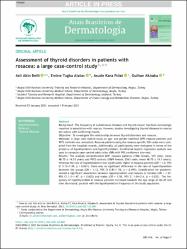| dc.contributor.author | Akın Belli, Aslı | |
| dc.contributor.author | Alataş, Emine Tuğba | |
| dc.contributor.author | Kara Polat, Asude | |
| dc.contributor.author | Akbaba, Gülhan | |
| dc.date.accessioned | 2021-07-29T08:27:52Z | |
| dc.date.available | 2021-07-29T08:27:52Z | |
| dc.date.issued | 2021 | en_US |
| dc.identifier.citation | Akin Belli A, Alatas ET, Kara Polat A, Akbaba G. Assessment of thyroid disorders in patients with rosacea: a large case-control study. An Bras Dermatol. 2021 Jul 15:S0365-0596(21)00173-2. doi: 10.1016/j.abd.2021.02.004. Epub ahead of print. PMID: 34275693. | en_US |
| dc.identifier.uri | https://doi.org/10.1016/j.abd.2021.02.004 | |
| dc.identifier.uri | https://hdl.handle.net/20.500.12809/9426 | |
| dc.description.abstract | Background: The frequency of autoimmune diseases and thyroid cancer has been increasingly reported in association with rosacea. However, studies investigating thyroid diseases in rosacea are scarce with conflicting results.
Objective: To investigate the relationship between thyroid disorders and rosacea.
Methods: A large case-control study on age- and gender-matched 2091 rosacea patients and 9572 controls was conducted. Rosacea patients using the rosacea-specific ICD codes were compiled from the hospital records. Additionally, all participants were evaluated in terms of the presence of hypothyroidism and hyperthyroidism. Conditional logistic regression analysis was used to compute case-control odds ratios (OR) with 95% confidence intervals.
Results: The analysis comprehended 2091 rosacea patients (1546 female, 545 male; mean 48.73 ± 14.53 years) and 9572 controls (7009 female, 2563 male; mean 48.73 ± 15.1 years). Whereas the rate of hypothyroidism was significantly higher in rosacea patients (OR = 1.3, 95% CI 1.13-1.49, p < 0.001), there was no significant difference in the rate of hyperthyroidism between the groups (OR = 1.12, 95% CI 0.81-1.53, p = 0.497). Stratification for genderrevealed a significant association between hypothyroidism and rosacea in females (OR = 1.27, 95% CI 1.1-1.47, p = 0.002) and males (OR = 1.58, 95% CI 1.04-2.4, p = 0.032). The frequency of hypothyroidism in rosacea patients increased towards the age range of 40-49 and then decreased, parallel with the hypothyroidism frequency of the study population.
Study limitations: Different subtypes and severities of rosacea were not distinguished.
Conclusions: Hypothyroidism may be a comorbidity of rosacea and investigation for hypothyroidism may be appropriate when evaluating rosacea patients. | en_US |
| dc.item-language.iso | eng | en_US |
| dc.publisher | Elsevier | en_US |
| dc.relation.isversionof | 10.1016/j.abd.2021.02.004 | en_US |
| dc.item-rights | info:eu-repo/semantics/openAccess | en_US |
| dc.subject | Hypothyroidism | en_US |
| dc.subject | Rosacea | en_US |
| dc.subject | Thyroid diseases | en_US |
| dc.title | Assessment of thyroid disorders in patients with rosacea: a large case-control study | en_US |
| dc.item-type | article | en_US |
| dc.contributor.department | MÜ, Tıp Fakültesi, Eğitim ve Araştırma Hastanesiü | en_US |
| dc.contributor.authorID | 0000-0002-4197-9716 | en_US |
| dc.contributor.institutionauthor | Akın Belli, Aslı | |
| dc.contributor.institutionauthor | Alataş, Emine Tuğba | |
| dc.relation.journal | Anais Brasileiros de Dermatologia | en_US |
| dc.relation.publicationcategory | Makale - Uluslararası Hakemli Dergi - Kurum Öğretim Elemanı | en_US |


















